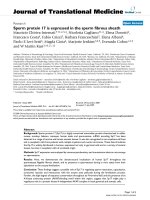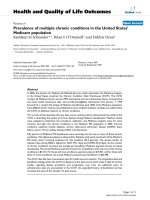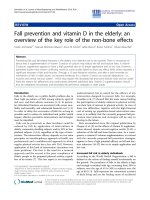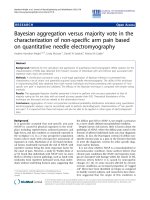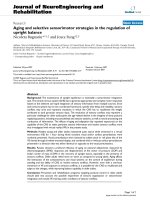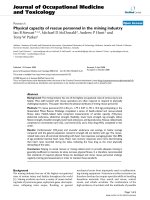Báo cáo hóa học: " Transvaginal evisceration progressing to peritonitis in the emergency department: a case report" potx
Bạn đang xem bản rút gọn của tài liệu. Xem và tải ngay bản đầy đủ của tài liệu tại đây (530.25 KB, 4 trang )
CAS E REP O R T Open Access
Transvaginal evisceration progressing to
peritonitis in the emergency department:
a case report
Luan Lawson
1*
, Leigh Patterson
1
and Kelly Carter
1,2
Abstract
Background: Abdominal pain is a common complaint among emergency department patients, making it essential
to identify those with life-threatening etiologies. We report on the rare finding of atraumatic transvaginal bowel
evisceration in a patient presenting to the emergency department with the primary complaint of abdominal pain.
Case Description: A 63-year-old female presented ambulatory to the emergency department with abdominal pain
and foreign body sensation in her vagina after coughing. Physical exam demonstrated evisceration of her small
bowel through her vagina. During her clinical course, she rapidly deteriorated from appearing well without
abdominal tenderness to hypotensive with frank peritonitis.
Conclusion: This case demonstrates the need to perform a thorough physical exam on all patients with
abdominal pain and details the management of vaginal evisceration. This case also highlights the difficulty of
appropriate triage for patients with complaints not easily assessed in triage. In an era of emergency department
crowding, emergency physicians should reevaluate nursing education on triaging abdominal pain to prevent
delays in caring for well-appearing patients who have underlying life-threatening illnesses.
Background
Abdominal pain is the most common presentation to US
emergency departments (ED) and accounts for 6.8% of all
visits [1]. Identifying those patients with abdominal pain
who are at risk for acute decompensatio n is essential.
Evisceration of bowel through the vagina is a rarely
reported complication of a hysterectomy. It is more com-
monly associated with trauma and conditions that increase
intra-abdominal pressure, including heavy lifting, coughing
or straining [2]. Much of the literature on this topic is
available in obstetrics and gynecology journals [2-4]. We
report this rare finding in a patient presenting to the
emergency department with the common chief complaint
of abdominal pain.
Case description
A 63-year-old G2P2 female presented ambulatory to the
ED with the chief complaint of abdominal pain, described
further to the triage nurse as abdominal cramping and a
mass in her vagina. The patient described that she had
had a “bulg e” in her vagina for the past 2 years and was
currently being treated by her gynecologist for an entero-
cele with estrogen cream. Elective surgical repair of an
enterocele was planned. She complained to the triage
nurse of abdominal pain intermitt ently for the p receding
1 week. She stated that when she coughed something
protruded from her vagina and she believed that he r rec-
tum had prolapsed. She was initially triaged to the lower
acuity area of the emergency depa rtment, but due to
worsening pain, she was brought back to a room on the
acute care side approximately 30 min after her arrival.
She described working in her garden when she coughed,
exp eriencing a “bulge ” extending through and out of her
vagina. According to the patient , this “ bulge” had been
worsening for 2 months but had never extended past her
labia. The patient complained of severe cramping in the
left lower quadrant of her abdomen, but denied any dif-
fuse abdominal pain. Her past medical history was signif-
icant f or hypertension and breast cancer treated with
surgery and chemotherapy without radiation. The patient
* Correspondence:
1
Department of Emergency Medicine, Brody School of Medicine, East
Carolina University, 600 Moye Boulevard, Greenville, NC 27834 USA
Full list of author information is available at the end of the article
Lawson et al. International Journal of Emergency Medicine 2011, 4:66
/>© 2011 Lawson et al; licensee Spri nger. This is an Open Access article distributed under the terms of the Creative Co mmons
Attribution License ( which permits unrestricted use, distribution, and reproduction in
any medium, provided the original work is properly cited.
did not have a h istory of vaginal or vulvar cancer. Her
surgical history was significant for mastectomy and
breast reconstruction, laparoscopic-assisted vaginal
hysterectomy and bilateral oopherectomy ( 5 years pre-
viously), and pubovaginal sling (4 years previously).
On examination she was pleasant, appearing well and
in no acute distress, with a temperature of 36.8 C°,
pulse of 70, and blood pressure of 142/9 7 mmHg. Initial
abdominal examination demonstrated no tenderness to
palpation and no peritoneal signs. On genitourinary
exam approximately 15 cm of small bowel protruded
through the vaginal introitus (see Figure 1). The bowel
exhibited peristaltic waves and was dark red in color.
Manual reduction was attempted to reduce strangula-
tion, but was unsuccessful b ecause of the large amount
of bowel present and to the patient’s discomfort during
the attempt. Intravenous morphine was administered for
pain control. Sterile moist gauze was placed over the
eviscerated bowel, and the gynecology department was
immediately consulted for surgical management of the
patient. The patient was given a bolus of 1 l normal sal-
ine and intravenous ertapenam and metronidazole to
cover enteric organisms.
Laboratory data results included white blood cell
count, 5.9 k/ul; hemoglobin, 13.1 g/dl; hematocrit,
38.6%; platelets, 287 k/ul; prothrombin time and partial
thromboplastin time were normal. Sodium was 142
mEq/l; chloride, 109 mEq/l; potassium, 3.8 mEq/l; bicar-
bonate 23 mEq/l; glucose, 123 mg/dl; blood urea nitro-
gen, 17 mg/dl; creatinine, 0.7 mg/dl; calcium 9.3 mg/dl.
The electrocardiogram showed normal sinus rhythm,
with left atrial enlargement.
While awaiting surgical consultation and 45 min after
being placed in a room, the patient developed relative
hypotension; her blood pressure decreased from 183/108
to 107/63 mmHg. She became less responsive and
experienced rigors. Repeat abdominal exam showed dif-
fuse abdominal tenderness with peritoneal signs that
rapidly progressed to frank peritonitis. The h erniated
bowel had become dark and dusky. A second large bore
IV was placed, and a ggressive fluid resuscitation with 2 l
normal saline was initiated. Her bed was placed in the
Trendelenburg position to reduce tension on the eviscer-
ated bowel, and pre parations w ere made t o intubate the
patient because of her rapid decline. The fluid resuscita-
tion was s uccessful in improv ing her mental status and
blood pressure, and she did not require intubation. She
was transported quickly to the operating room for repair
by both gynecology and general surgery physici ans. Gen-
eral surgery resected approximately 20 cm of the distal
ileum, which they noted to be inflamed and thickened
with two areas of ischemia. This was followed by resection
and repair of the vaginal cuff by gynecologic surgery. The
patient was discharged from the hosp ital 6 days later in
improved condition.
Discussion
Since the first account of transvaginal evisceration was
reported in the English literature in 1907, fewer than
100 cases have been reported [2-5]. This literature is
predominantly in the fields of obstetrics and gynecology,
and only two articles on this topic have been presented
in journals specific to emergency medicine [6,7]. Not all
cases of evisceration are as obvious as our patient, so
patients with similar complaints without obvious bowel
herniation should undergo a pelvic exam to assess for
the presence of cuff defect and transvaginal evisceration.
Physicians should recognize this condition largely occurs
among patients who have undergone menopause or hys-
terectomy. A large case series from a single institution
concluded that this diagnosis should be considered in
any woman presenting with acute vaginal bleeding and
pelvic pain, especially postmenopausal women with a
history of prolapse and pelvic surgery [4]. The median
time to evisceration after pelvic surgery is 20 months
[2]. Most patients report sudden onset of abdominal
pain, a mass protruding from the vagina, vaginal bleed-
ing, nausea, or vaginal discharge [2]. Despite the poten-
tial for significant morbidity, most patients with
transvaginal evisceration present with acute, but subtle
symptoms and rarely display evidence of peritonitis on
presentation [2]. The combinatio n of subtle presenting
complaints and the need for a pelvic exam to obtain the
clinical diagnosis predispose these patients to delayed
diagnosis.
Emergency department management of a patient wit h
transvaginal evisceration was discussed by Guttman et al.
in 1990 and parallels the appro ach taken in our case: sta-
bilization including fluid therapy, wrapping the exposed
bowel in saline-soaked gauze, and administration of
Figure 1 Transvaginal evisceration of small bowel.
Lawson et al. International Journal of Emergency Medicine 2011, 4:66
/>Page 2 of 4
broad-spectrum antibiotics that cover gastrointestinal
flora in preparation for i mmediate surgical repair. If the
protruding intestines appear viable with obvious peristal-
sis and pink coloration, sterile saline irrigation of the
exposed bowel and manual replacement through the
vaginal cuff should be attempted [2,7,8]. If the reduction
is successful, the patient may undergo prima ry transvagi-
nal cuff repair without laparotomy. If the bowel cannot
be reduced, the patient should proceed directly to lapar-
otomy. Both gynecologic and general surgery should be
consulted since definitive treatment may require bowel
resection as well as vaginal cuff repair. The combined
approach allows fo r more thorough inspection of the
bowel and resection of ischemic sections as necessary.
Gynecology can then proceed with vaginal cuff repair.
Transvaginal eviscerations have resulted in two
reported deaths; therefore, it is important to include it in
the differential diagnosis of a woman presenting with
abdominal pain, perform a complete physical exam, and
treat an evisceration promptly [7]. Laboratory values
including CBC and electrolytes may be helpful in identi-
fying patients with unanticipated anemia or electrolyte
abnormali ties; ho wever, no laboratory results are sp ecific
in identifying patients with transvaginal evisceration.
Serum lactate may predict the presence of ischemic
bowel, but a normal serum lactate does n ot preclude the
need for surgical intervention. Early recognition as well
as management is the cornerstone of reducing morbidity
and mortality associated with this subtle but serious
condition.
According to the National Hospital Ambulatory Medical
Care Survey data, abdominal pain is the most common
presentation to US emergency departments [9]. Emer-
gency department overcrowding has been associated with
delayed care in patients with severe pain [10,11]. This case
highlights the challenges of appropriately triaging patients
whose complaints are not easily assessed in triage. Accord-
ing to most triage classifications, abdominal pain repre-
sents an urgent condition that requires prompt care, but
will not cause life or limb threat if not treated for several
hours. Abdominal pain i s the most frequent presenting
chief complaint to US emergency departments and repre-
sents a broad spectrum of d isease states ranging from
benign to life-threatening etiologies. The etiology of our
patient’s pain was easily recognized in the treatment area,
but her well appearance and the vagueness of her symp-
toms led the triage nurse to classify this patient as urgent
instead of emergent. In many over-utilized US EDs, this
non-emergent classification of patients with transvaginal
evisceration could lead to significant delays in diagnosis.
Without prompt att ention to her worsening p ain, th is
patient could have experienced an adverse outcome.
Triage nurses should be educated to recognize benign-
appearing presentations of li fe-threatening condit ions.
From 1997 through 2006, the number of ED visits
increased from 94.9 million to 119.2 million, representing
an increase of 24 percent [9]. A national survey of ED
directors defined ED crowding as waiting greater than 1 h
toseeaphysician;thiswaitismorelikelytoresultin
adverse outcomes [ 12]. Studies have found disagreement
exists among health care professionals about the urgent
needs of emergency department patients even when using
the same criteria [13-15]. EM ph ysicians should consider
alternative triage methods for patients with sensitive com-
plaints possibly representing life-threatening emergencies
that can’t be appropriately assessed in a semi-private triage
area to reduce the morbidity and mortality associated with
delayed diagnosis. Triage nurses should be educated on
the importance of regular reassessment of vital signs since
patients who appear stable on initial presentation may
rapidly decompensate.
Conclusion
This case demonst rates the need to perform a thorough
physical exam on all patients with abdominal pain and
details the management of vaginal evisceration. This
case also highlights the difficulty of appropriate triage
for patients with complaints not easily assessed in triage.
In an era of emergency department crowding, emer-
gency physicians should reevaluate nursing education on
triaging abdominal pain to prevent delays in caring for
well-appearing patients w ho have underlying life-threa-
tening illnesses.
Consent
Written informed consent was obtained from the patient
for publication of this case report and any accompany-
ing images. A copy of the written consent is avail able
for review by the Editor-in-Chief of this journal.
Author details
1
Department of Emergency Medicine, Brody School of Medicine, East
Carolina University, 600 Moye Boulevard, Greenville, NC 27834 USA
2
Johnston Memorial Hospital, 351 Court Street North East, Abingdon, VA
24210 USA
Authors’ contributions
KC treated the patient in the ED and was involved in drafting the
manuscript. LL cared for the patient in the ED and was involved in drafting
the manuscript, major revisions, and editing of the manuscript. LP was
involved in critical editing and revisions of the manuscript. LL and LP
participated in its design and coordination. All authors read and approved
the final manuscript.
Authors’ information
LL, Assistant Professor, Department of Emergency Medicine, Brody School of
Medicine at East Carolina University, Greenville, NC
LP, Assistant Professor, Department of Emergency Medicine, Brody School of
Medicine at East Carolina University, Greenville, NC
KC, Emergency Medicine , Johnston Memorial Hospital, Abingdon, VA
Competing interests
The authors declare that they have no competing interests.
Lawson et al. International Journal of Emergency Medicine 2011, 4:66
/>Page 3 of 4
Received: 25 August 2011 Accepted: 13 October 2011
Published: 13 October 2011
References
1. McCaig LF, Nawar EW: National hospital ambulatory medical care survey:
2004 Emergency Department summary. Adv Data 2006, 23(372):1-29.
2. Ramirez PT, Klemer DP: Vaginal evisceration after hysterectomy: a
literature review. Obstet Gynecol Surv 2002, 57(7):462-7, Review.
3. Nasr AO, Tormey S, Aziz MA, Lane B: Vaginal herniation: case report and
review of the literature. Am J Obstet Gynecol 2005, 193(1):95-7, Review.
4. Croak AJ, Gebhart JB, Klingele CJ, Schroeder G, Lee RA, Podratz KC:
Characteristics of patients with vaginal rupture and evisceration. Obstet
Gynecol 2004, 103(3):572-6.
5. McGregor AN: Rupture of the vaginal wall with protrusion of small
intestine in a woman 63 years of age: Replacement, suture, recovery. J
Obstet Gynecol Br Emp 1907, 11:252-258.
6. Guttman A, Afilalo M: Vaginal evisceration. Am J Emerg Med 1990,
8(2):127-8.
7. Ferrera PC, Thibodeau LG: Vaginal evisceration. J Emerg Med 1999,
17(4):665-7.
8. Ginsberg G, Rovner E, Raz S: Vaginal evisceration. Urology 1998,
51(1):128-129.
9. Niska R, Bhuiya F, Xu J: National Hospital Ambulatory Medical Care
Survey: 2007 Emergency Department Summary. Natl Health Stat Report
2010, , 26: 1-31.
10. Mills AM, Shofer FS, Chen EH, Hollander JE, Pines JM: The association
between emergency department crowding and analgesia administration
in acute abdominal pain patients. Acad Emerg Med 2009, 16(7):603-8,
Epub 2009 Jun 22.
11. Hwang U, Richardson L, Livote E, Harris B, Spencer N, Sean Morrison R:
Emergency department crowding and decreased quality of pain care.
Acad Emerg Med 2008, 15(12):1248-55, Epub 2008 Oct 17.
12. Derlet RW, Richards JR, Kravitz RL: Frequent overcrowding in US
emergency departments. Acad Emerg Med 2001, 8:151-155.
13. Wuerz R, Fernandes CM, Alarcon J: Inconsistency of emergency
department triage. Emergency Department Operations Research
Working Group. Ann Emerg Med 1998, 32(4):431-5.
14. Brillman JC, Doezema D, Tandberg D, Sklar DP, Davis KD, Simms S,
Skipper BJ: Triage: limitations in predicting need for emergent care and
hospital admission. Ann Emerg Med 1996, 27(4):493-500.
15. Gill JM, Reese CL, Diamond JJ: Disagreement among health care
professionals about the urgent care needs of emergency department
patients. Ann Emerg Med 1996, 28(5):474-9.
doi:10.1186/1865-1380-4-66
Cite this article as: Lawson et al.: Transvaginal evisceration progressing
to peritonitis in the emergency department: a case report. International
Journal of Emergency Medicine 2011 4:66.
Submit your manuscript to a
journal and benefi t from:
7 Convenient online submission
7 Rigorous peer review
7 Immediate publication on acceptance
7 Open access: articles freely available online
7 High visibility within the fi eld
7 Retaining the copyright to your article
Submit your next manuscript at 7 springeropen.com
Lawson et al. International Journal of Emergency Medicine 2011, 4:66
/>Page 4 of 4

